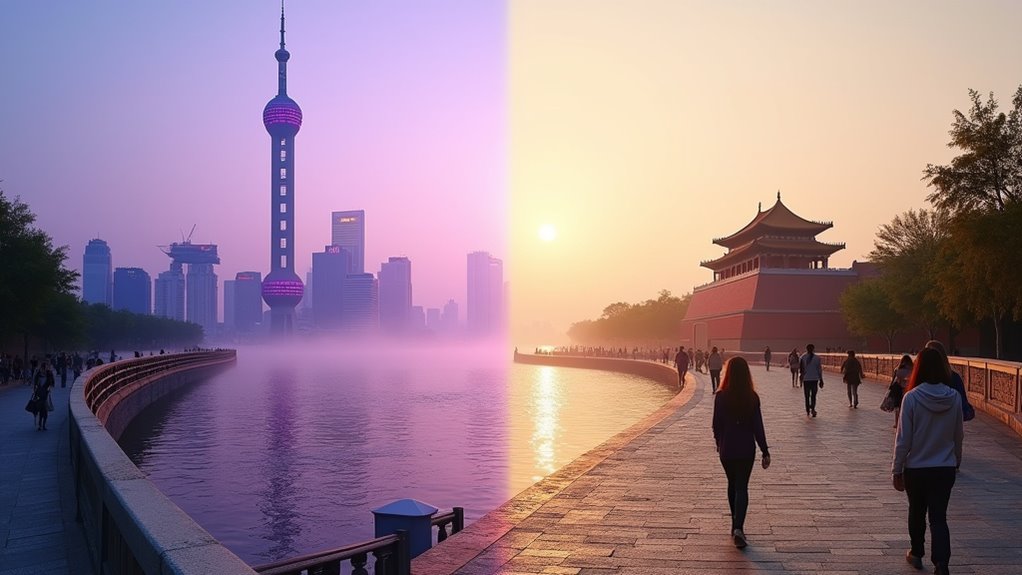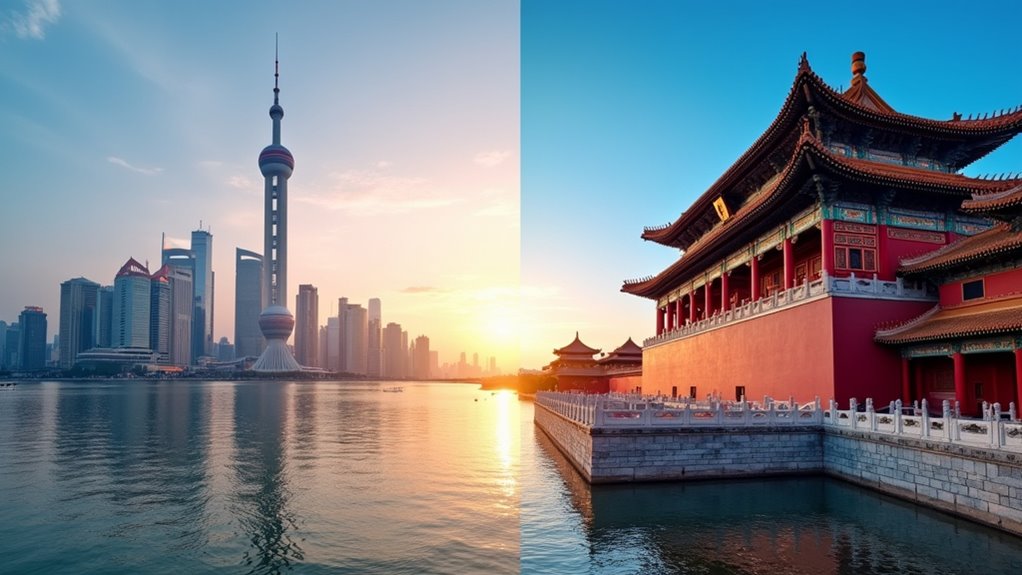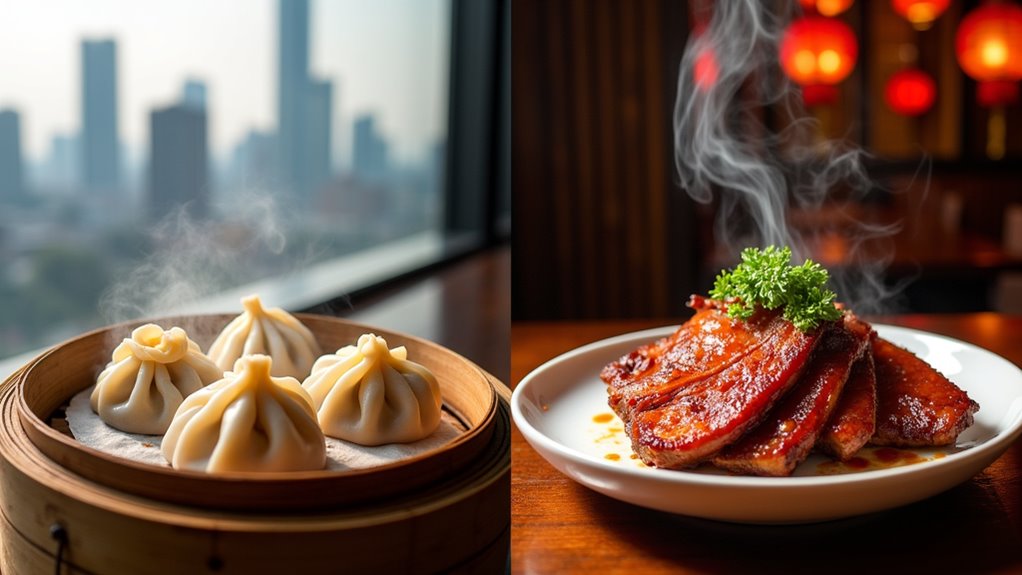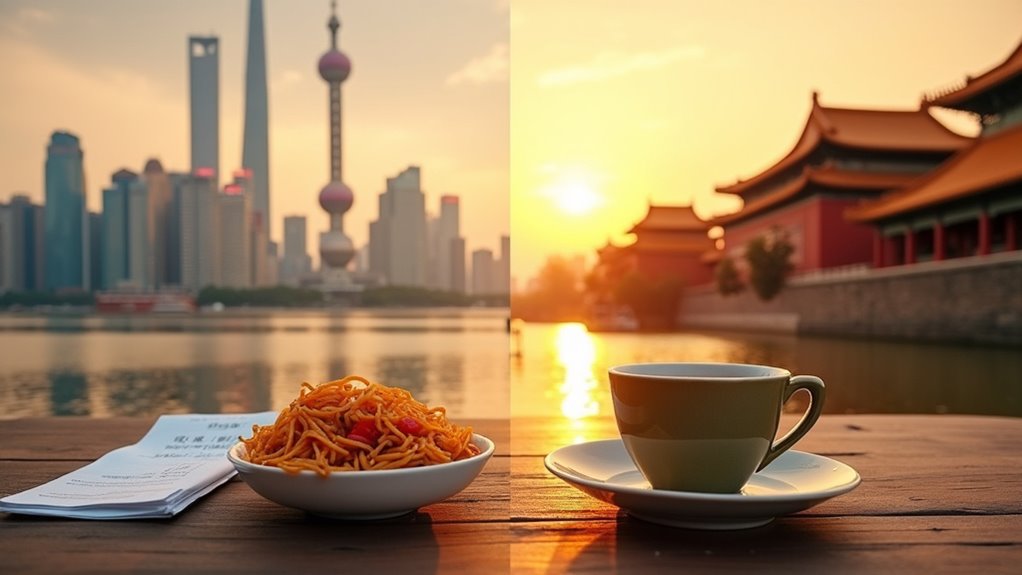Physical Address
304 North Cardinal St.
Dorchester Center, MA 02124
Physical Address
304 North Cardinal St.
Dorchester Center, MA 02124

One must choose wisely between historic Beijing or cosmopolitan Shanghai—discover which Chinese metropolis perfectly matches your travel style.
Choose Beijing for imperial history (Forbidden City, Great Wall) and authentic northern cuisine like Peking duck, or Shanghai for colonial-meets-futuristic architecture and international fusion food. Beijing offers deeper culture at lower costs, while Shanghai delivers cosmopolitan energy with higher price tags. Both have excellent metro systems and can be connected by high-speed rail. Your preference for traditional versus modern China will guide your perfect choice.

When comparing Shanghai and Beijing, you’ll immediately notice their striking architectural contrasts. Shanghai presents a cosmopolitan blend where colonial structures along the Bund stand beside futuristic skyscrapers like the Shanghai Tower. The city seamlessly integrates its international past with cutting-edge design throughout its urban landscape. The breathtaking skyline views from the Oriental Pearl Tower offer visitors a dramatic perspective of Shanghai’s architectural evolution.
Beijing, however, offers a more distinct separation between old and new. The imperial grandeur of the Forbidden City and traditional hutong neighborhoods provide a stark contrast to modern marvels like the Bird’s Nest Stadium. While planning your Chinese adventure, consider that both cities offer vastly different experiences than what you might find in Southeast Asia destinations like Laos.
While Shanghai’s architecture reflects its evolution as a global financial hub, Beijing’s buildings often symbolize national cultural identity. Both cities balance preservation with progress, but Shanghai tends to blend these elements while Beijing maintains clearer historical boundaries.
Both Shanghai and Beijing boast iconic attractions that reflect their unique cultural identities and historical significance. In Shanghai, you’ll discover The Bund’s colonial architecture, Yu Garden’s traditional charm, and the futuristic Oriental Pearl Tower dominating the skyline.
For natural beauty, cruise the Huangpu River or explore Zhujiajiao Water Town’s picturesque canals. The water town offers a highly rated experience with boat rides that showcase traditional Chinese scenery just 39 miles from the city center.
Beijing offers China’s most renowned historical treasures, including the Great Wall, Forbidden City, and Temple of Heaven.
Nature lovers can hike Mount Xiangshan or enjoy Fragrant Hills’ scenic trails.
The city’s cultural scene features traditional Beijing Opera performances and bustling markets like Wangfujing.
While Shanghai tempts with its blend of modernity and tradition, Beijing enthralls with its imperial history and cultural depth, offering distinctly different experiences for travelers. Like choosing between island escapes in the Philippines, your decision should ultimately depend on your preference for either modern urban experiences or deep historical immersion.

A journey through China’s major cities reveals dramatically different culinary landscapes that reflect centuries of regional history and cultural evolution.
In Beijing, you’ll savor iconic Peking duck and hearty lamb hot pot amid traditional hutong eateries. The capital’s cuisine features wheat-based, savory dishes with Shandong and Muslim influences.
Beijing’s distinct culinary identity shines through its wheat-forward dishes, where ancient traditions meet the flavors of Shandong and Islamic heritage.
Shanghai offers delicate xiaolongbao dumplings and seasonal specialties like bamboo shoot soup. Its food scene blends Jiangsu-Zhejiang traditions with Western influences, featuring more seafood and lighter flavors. Many visitors appreciate Shanghai‘s sweeter cuisine options compared to Beijing’s robust flavor profiles.
Price points vary widely in both cities, from 10 RMB street snacks to 500+ RMB fine dining experiences. Shanghai boasts more international diversity, though Beijing’s expat areas are catching up. The decision between these two cities often comes down to your preference for traditional flavors versus international fusion cuisine.
After pandemic struggles, both cities have rebounded strongly in 2025, with government-backed dining campaigns fueling recovery.
Finding your way through China’s mega-cities requires strategic planning and an understanding of the all-encompassing transportation networks that keep these urban giants moving.
You’ll discover that both Shanghai (19 lines) and Beijing (27 lines) boast extensive metro systems that outshine their bus networks for efficiency.
When traveling between these metropolises, consider the tradeoffs: flights take 2-2.5 hours but face delays and higher costs, while high-speed trains deliver you in 4.5-6 hours with countryside views and greater punctuality.
For intracity navigation, public transit trumps private vehicles in both practicality and cost-efficiency. Traffic congestion makes car travel impractical for most visitors. Having your destination written in Chinese characters can significantly improve communication with taxi drivers and prevent navigation issues.
Unlike Vietnam where motorbike rentals are popular for travelers exploring the country, China’s urban centers are not conducive to this mode of transportation.
Take advantage of China’s sophisticated online booking systems and mobile payment options to streamline your journey through these fascinating urban landscapes.

Budgeting for your Chinese mega-city adventure reveals considerable differences between Shanghai and Beijing that will directly impact your wallet. Shanghai consistently ranks as the pricier destination, particularly for accommodations and dining. You’ll pay 20-30% more for international restaurants in Shanghai, while Beijing offers better street food deals in its historic hutongs. Transportation between cities via high-speed rail costs around $72 from Beijing to Nanjing, making train travel options an important consideration in your overall budget. The cost disparities between these Chinese cities differ significantly from destinations like Bali, where average travel costs tend to be lower overall for Western travelers.
Attraction costs vary markedly: Beijing’s Forbidden City ($8-15) versus Shanghai Tower’s observatory ($25-35). Beijing offers better bargains at markets like Panjiayuan for souvenirs, whereas Shanghai’s customization services cost 15-30% more.
Timing matters too. Beijing’s hotels spike 50-100% during October holidays, while Shanghai sees 30-50% increases in spring. For budget travelers, Beijing’s winter brings substantial discounts, sometimes reaching 40% off regular rates.
While Beijing showcases China’s imperial past and Shanghai embodies its future, don’t feel you must choose between them. You might worry about spreading yourself too thin by visiting both, but these cities complement each other perfectly. Each offers distinct experiences that together provide a more complete picture of China’s complex identity. Consider your priorities—history, modernity, cuisine, or budget—and let those guide your decision.